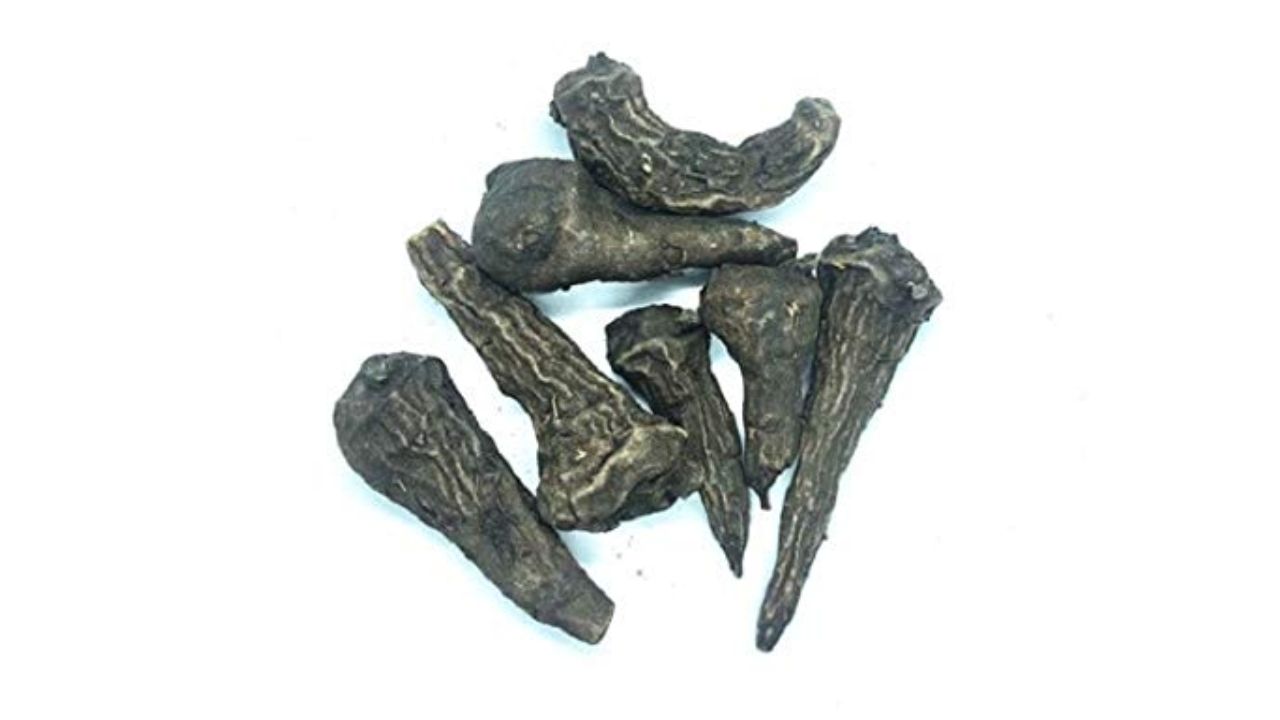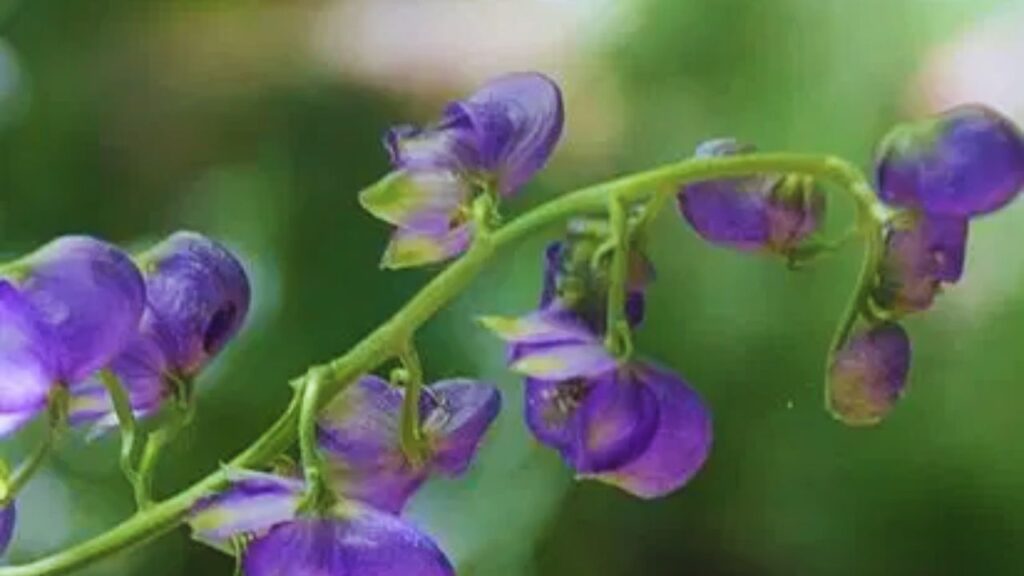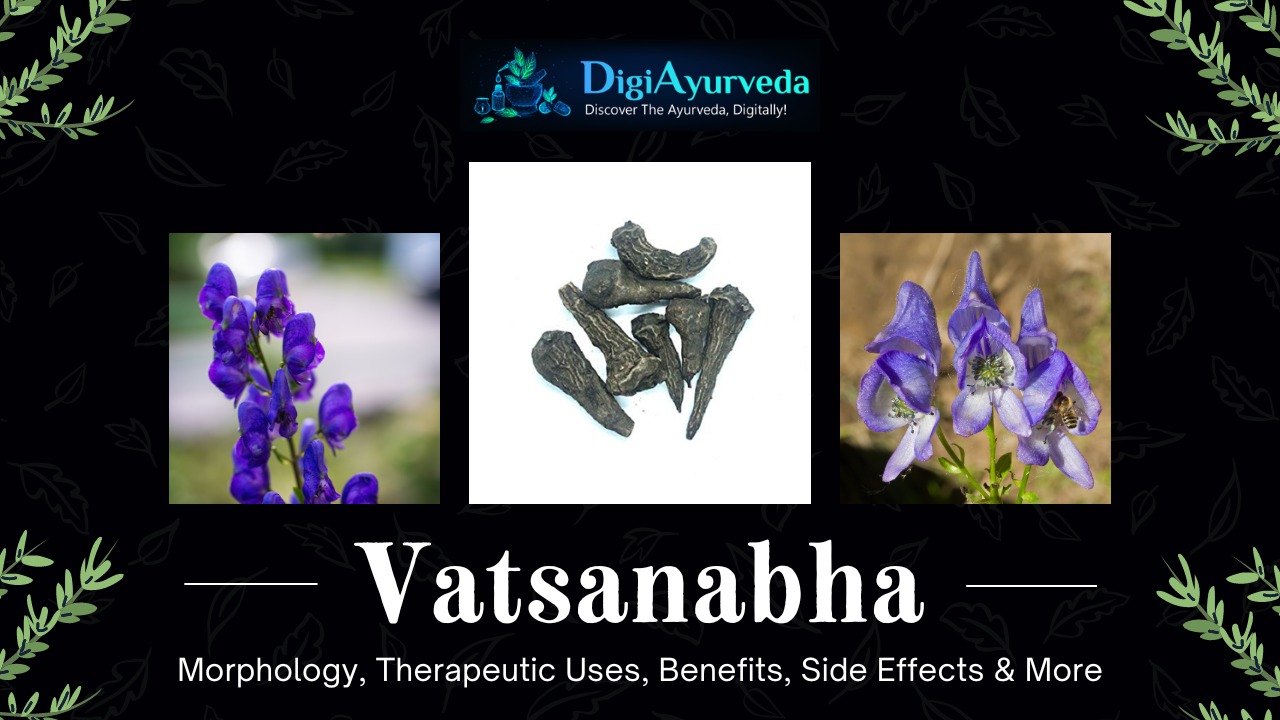
Family : Ranunculaceae
Biological classification
- Kingdom: Plantae
- Subkingdom: Viridiplantae
- Division: Tracheophyta
- Subdivision: Spermatophytina
- Class: Magnoliopsida
- Order: Ranunculales
- Family: Ranunculaceae
- Genus: Aconitum L.
- Species: Aconitum ferox Wall. ex Ser
Introduction To Vatsanabha
Aconitum ferox forms the principal source of the Indian poison known variously as bikh, bish, and nabee. It contains large quantities of the extremely toxic alkaloid pseudaconitine. It is considered to be the most poisonous plant found in the Himalaya and one of the most poisonous in the world.

Habitat / place of origin
Aconitum ferox distributed throughout India and other Asian countries.
Synonyms of Vatsanabha
Sanskrit : Vatsnabh, Vish , Amrit
Assamese: Mithavish , Bish
Bengali: Kathvisha , Mitha Visha
English: Monk’s Hood , Aconite
Gujarati: Bachnaag
Hindi: Bachnaag , Mitha Visha , Mitha Teliya
Kannada: Vatsanabhi
Kashmiri: Vachnaag
Malyalam: Vatsanabhi
Marathi: Bachnaga
Oriya: Tahara , Mahura , Mitha Visa
Punjabi: Mitha Visha , Mithatelia
Tamil : Vasanaavi, Vastanabhi , Nabhi , Vasanabhi
Telugu: Vatsanaabhi , Naabhi
Unani: Bachnak , Mithalelia , Beesh , Atees
Morphology of Vatsanabha
It is a perennial plant , tuberous rooted and herbaceous shrub of 3 feet height
Leaves : Simple leaves alternate and oval shaped towards the bottom they are larger sized and on the top the leaves are small/shorter
Flower: Bisexual , terminal raceme , bluish purple colour
Fruit : Follicular type fruit , oblong and oblique and seed are obovoid bipyramidal , 2.6-3mm long
Flowering time: July – November
Fruiting time : July – November
Medicinal Parts of Vatsanabha
Root

Plant variety of Vatsanabha
According to colour there are two types :
- White: natural type
- Black: the white type is artificially coloured black
Chemical Composition of Vatsanabha
- Aconite
- Pseudo -aconite
- Bikhaconitine
- Chasmoaconitine
- Indaconitine
- Catecholamine
- Isoquinolines
Ayurvedic Properties of Vatsanabha
Rasa (Taste) : Madhur
Guna (Quality) : Ruksha , Tikshna , Laghu , Vayvay , Vikshi ,
Virya (Potency) : Ushna
Vipak (Post Digestive Effect): Madhur
Karma (Pharmacological Actions) of Vatsanabha
Dosha Karma: It is Tridosha Shamak .
Sansthanik Karma (General Indications ): Vednasathpan , Shoth Har ,
Nadisansthan (Cns): No Direct On Brain
Pachnasansthan (Digestive System ): Hrilaas , Lala Shrav , Rochikar , Depan , Pachan , Shool Parshman , Yakrit Uttejak
Raktvahsansthan(Cvs): Hridya Avsadak In Impure Form And In Pure Form It Is Hridya Uttejak , If Purification Process Is Done With Cow Milk Then It Is Increases The BP , Shoth Har
Swasansasthan (Respiratory System ): Kaphghan , Swasan Kendra Uttejak
Mutravahsansthan (Urinary System ): Mutrajanana , Decreases The Sugar In Urine
Prajanansasthan (Reproductive System ): Shukra Stambhan , Aartavjanan
Tavcha (Skin ): Kusthghan , Swedjanana
Tapkarma (Thermoregulations): Jwarnashak
It Is Balaya In Small Quantity And Brihan
Qualities/Effects on Tridosha of Vatsanabha
It decrease the kapha dosha by ruksha , tikshan , laghu . it decrease the pitta dosha by madhur and vata by ushna.
Formulations of Vatsanabha
- Higuleshvar rasa
- Shrityunjay rasa
- Anambra rasa
- Jawarmurari
- Panchvastra
- Saubhagyavati
- Ramband kaphketu
Therapeutic Uses of Vatsanabha
- Indicated in Tridosha diseases
- It is indicated in fever ,
- Chronic fever
- Inflammation induces fever
- Common cold
- Cough
- Asthma
- Poor digestion
- Indigestion
- Respiratory infections
- Diabetes
- Splenomegaly
- Anorexia
Dosage of Vatsanabha
1/8 ratti
How can you consume Vatsanabha?
It is used in different variety of formulations . It is used as oil for massage, as lepa . It is used as tablets , sawras

Benefits of Vatsanabha
- Improves the digestion, relives the coldness
- Improves the strength
- It is used in anorexia , indigestion ,
- Useful in snake bite , rodent bite m scorpion bite
- Relives the back pain , hip pain
- Useful in sciatica
- Useful in headache
- Useful in ear pain
- Relives the ear swelling
- Also the eye swellings
- Useful in conjunctiva
- Useful in night blindness
- Used in treatment of paralysis , hemiplegia , neuropathy
- Useful in rheumatoid arthritis
- Useful in fever
- Useful in anaemia
- In first stage of liver disorder
- Looses the stool
- Used in IBS
- Used in malabsorption syndrome
- Used in piles fistula
- Used in COPD and other respiratory diseases
- Used in cough and cold
- Used in splenomegaly
- Improves the immunity
- Used in chronic fever
- Improves sperm quality and quantity
Side Effects of Vatsanabha
8 stages of toxic effect of Vatsanabha
- Stage 1 – twak vikara (skin rashes)
- Stage 2- vepathu (tremors )
- Stage 3- daha ( burning sensations all over the body )
- Stage 4 – vikranta (deformities )
- Stage 5 – phenodgati (frothing )
- Stage 6 – Skandha bhang (drooping and wasting of shoulders )
- Stage 7 – jadyta (wasting and comatose of all body )
- Stage 8 – marana (death)
Other effects :-
- Dilations of pupils
- Vertigo
- Blindness
- Respiratory and cardiac arrest
- Paralysis of upper and lower limbs
- Nervous damage
- Comma
- Death
Safety Precautions of Vatsanabha
- Used only in small quantity
- Contraindicated for pregnant and lactating mothers
- Taken only in pure form and after purifications process
|
Contraindications |
Reasons |
|
In summer and rainy seasons |
natural aggravations of vata and pitta |
|
In chronic diseases |
Requirement of prolonged medication |
|
Pitta dominant people |
Potential of pitta aggravating property |
|
Infants |
Unpredictability and fast actions |
|
Elderly |
Unpredictable and fast action |
|
Pregnancy |
May harm the fetus |
|
Dehydration |
Poor vital status |
|
Physical examination |
Poor vital status |
|
At vitals |
Local irritation |
Antidote of Vatsanabha
Antidote :
- one should given ghee along tankan bhasma
- Combination of ghee +honey + arjuna
Substitutes & Adulterants of Vatsanabha
Substitute : Jadwar (delphinium denudatum )
Adulteration:
- A.chasmanthum
- A. balfourii
- A. deniorrhizum
- A. falconeri
- A. nepallus
Purification of vatsanabha
- For the purification roots are cut and tie in a cotton cloth.
- Tied pieces are dipped in cow urine for three days.
- After exposure to sunlight the cow’s urine is replace with water.
- After third day purified root are dried and persevered.
References & Further Reading
- DRAVYAGUNA VIGYAN = PV SHARMA
- https://www.planetayurveda.com/library/vatsanabha-aconitum-ferox/
- https://www.easyayurveda.com/2012/08/24/vatsanabha-benefits-toxic-effects-purification-dosage/
- https://www.researchgate.net/publication/312161895_A_review_of_Aconite_Vatsanabha_usage_in_Ayurvedic_formulations_traditional_views_and_their_inferences
- https://www.google.com/url?sa=t&source=web&rct=j&url=https://www.wjpmr.com/download/article/50082019/1567165703.pdf&ved=2ahUKEwjlurWn4f3wAhWK0TgGHdKiBvwQFjACegQIBhAC&usg=AOvVaw2_QkaCSMVy7EtVby26LeN4




